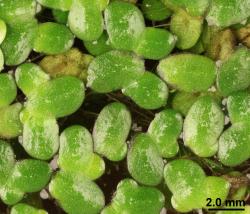- Taxon
- Gallery
Classification
Class
Family
Genus
Nomenclature
Scientific Name:
Lemna minor L. (1753)
Vernacular Name(s):
Common duckweed; kārearea; Lesser duckweed
Description
Platelets to 6 × 4 mm., but us. much smaller, suborbicular to elliptic-obovate, nearly symmetric; dorsal surface green, flat to slightly convex, obscurely 3-veined; ventral surface flat to slightly convex, occ. tinged with red or purple. Root single, long, its proximal part lying in a furrow in the frond tissue; root-cap conspicuous. Spathe open at top. Ovule solitary. Fr. ovoid, wingless, projecting beyond the pouch margin. Seed obovate, flattened, smooth; operculum ± flattened.
[From: Moore and Edgar (1970) Flora of New Zealand. Volume 2.]
Biostatus
Indigenous (Non-endemic)
Phenology
Flowering: Nov.–Dec.–(Feb.)
Bibliography
de Lange, P.J.; Rolfe, J.R.; Barkla J.W.; Courtney, S.P.; Champion, P.D.; Perrie, L.R.; Beadel, S.N.; Ford, K.A.; Breitwieser, I.; Schönberger, I.; Hindmarsh-Walls, R.; Heenan, P.B.; Ladley, K. 2018: Conservation status of New Zealand indigenous vascular plants, 2017. New Zealand Threat Classification Series. No. 22. [Not Threatened]
de Lange, P.J.; Rolfe, J.R.; Champion, P.D.; Courtney, S.P.; Heenan, P.B.; Barkla, J.W.; Cameron, E.K.; Norton, D.A.; Hitchmough, R.A. 2013: Conservation status of New Zealand indigenous vascular plants, 2012. New Zealand Threat Classification Series 3. Department of Conservation, Wellington. [Not Threatened]
Landolt, E. 1986: Biosystematic investigations in the family of duckweeds (Lemnaceae) Vol. 2. The family of Lemnaceae—a monographic study Vol.1, Veroeffentlichungen des Geobotanischen Institutes der ETH, Stiftung Ruebel, in Zuerich 71. Heft: 566.




